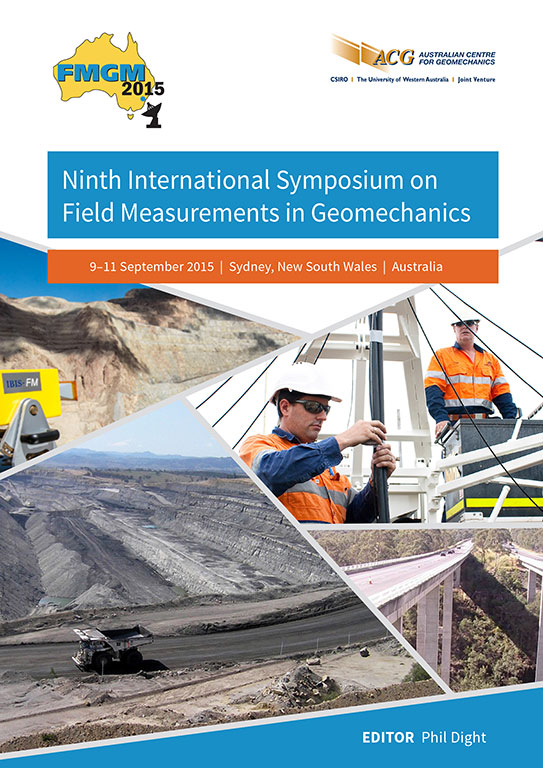On the use of ground-based synthetic aperture radar for long-term slope monitoring to support the mine geotechnical team

|
Authors: Leoni, L; Coli, N; Farina, P; Coppi, F; Michelini, A; Costa, TA; Costa, TAV; Costa, F |
DOI https://doi.org/10.36487/ACG_rep/1508_58_Farina
Cite As:
Leoni, L, Coli, N, Farina, P, Coppi, F, Michelini, A, Costa, TA, Costa, TAV & Costa, F 2015, 'On the use of ground-based synthetic aperture radar for long-term slope monitoring to support the mine geotechnical team', in PM Dight (ed.), FMGM 2015: Proceedings of the Ninth Symposium on Field Measurements in Geomechanics, Australian Centre for Geomechanics, Perth, pp. 789-796, https://doi.org/10.36487/ACG_rep/1508_58_Farina
Abstract:
Nowadays, ground-based synthetic aperture radar interferometry (GBInSAR) is used internationally as a leading edge tool for the near real time monitoring of slope movements on landslides and open pit mines for both safety-critical or background monitoring purposes. The success of the technology relies mainly on its ability to rapidly measure slope movements with sub-millimetre accuracy over wide areas and in almost any weather condition. In this paper an advanced data processing chain able to simultaneously measure a wide range of deformation rates, across four orders of magnitudes, from moderate movements (up to 150 mm/hour) to extremely low displacements (few mm/month), is presented. The use of this processing for long-term monitoring may result in an early detection of slow movements and eventually the setup of remedial before they start to interfere with operations or problems become too difficult or expensive to be managed. The advantages and site experiences are presented along with recent successful studies in several Brazilian iron ore mines with different characteristics, owned by Vale S.A. In the sites radar data have been integrated and compared to displacement measurements acquired by traditional monitoring systems, in order to improve the interpretation of the local slope movements and predict failure mechanisms. This technique is now applied to support long-term monitoring, adding to the traditional systems to provide the necessary reliability, coverage and safety.
References:
Antonello, G, Casagli, N, Farina, P, Leva, D, Nico, G, Sieber, AJ & Tarchi, D 2004, ‘Ground based SAR interferometry for monitoring mass movements’, Landslides, vol. 1, no. 1, pp. 21-28.
Bozzano, F, Cipriani, I, Mazzanti, P & Prestininzi, A 2011, ‘Displacement patterns of a landslide affected by human activities: insights from ground-based InSAR monitoring’, Natural Hazards, vol. 59, no. 3, pp. 1377-1396.
Costa, AT, Costa, TAV, Sayão, AS & Nunes, ALLS 2013, ‘Monitoring of the VALE Córrego do Feijão mine using interferometric radar’, Proceedings of the 14th Brazilian Congress of Geology and Environmental Engineering (COBRAE), pp. 120-128.
Farina, P, Coli, N, Yön, R, Eken, G & Ketizmen, H 2013, ‘Efficient real time stability monitoring of mine walls: the Cöllolar Mine case study’, Proceedings of the 23rd International Mining Congress and Exhibition of Turkey, pp. 111-117.
Farina, P, Leoni, L, Babboni, F, Coppi, F, Mayer, L & Ricci, P 2011, ‘IBIS-M, an innovative radar for monitoring slopes in open-pit mines’, in E Eberhardt & D Stead (eds), Proceedings of the 11th International Symposium on Rock Slope Stability in Open Pit Mining and Civil Engineering, Canadian Institute of Mining, Metallurgy and Petroleum, Westmount, Quebec, 9 p.
Girard, JM 2001, ‘Assessing and monitoring open pit mine highwalls’, in FM Jenkins, J Langton, MK McCarter & B Rowe (eds), Proceedings of the 32nd Annual Institute of Mining Health, Safety and Research, pp. 159-171.
Gross, GA 1980, ‘A classification of iron formation based on depositional environments’, The Canadian Mineralogist, vol. 18, pp. 215-222.
Kayesa, G 2006, ‘Prediction of slope failure at Letlhakane Mine with the Geomos slope monitoring system’, Proceedings of the International Symposium on Stability of Rock Slopes in Open Pit Mining and Civil Engineering Situations, Series S44,
pp. 605-622.
Morgan, R, Orberger, B, Rosière, CA, Wirth, R, Carvalho, CDM & Bellver-Baca, MT 2013, ‘The origin of coexisting carbonates in banded iron formations: a micro-mineralogical study of the 2.4 Ga Itabira Group, Brazil’, Precambrian Research, vol. 224, pp. 491-511.
Osasan, KS & Afeni, TB 2010, ‘Review of surface mine slope monitoring techniques’, Journal of Mining Science, vol. 46, no. 2, pp. 177-186.
Pieraccini, M 2013, ‘Real beam vs. synthetic aperture radar for slope monitoring’, Proceedings of the Progress in Electromagnetics Research Symposium (PIERS), The Electromagnetics Academy, Cambridge, MA, pp. 1627-1632.
United States Department of the Interior 1969, Physiographic, stratigraphic and structural development of the Quadrilátero Ferrífero, Minas Gerais: Geological Survey Professional Paper, prepared by JVN Dorr II, Washington DC.
© Copyright 2025, Australian Centre for Geomechanics (ACG), The University of Western Australia. All rights reserved.
View copyright/legal information
Please direct any queries or error reports to repository-acg@uwa.edu.au
View copyright/legal information
Please direct any queries or error reports to repository-acg@uwa.edu.au